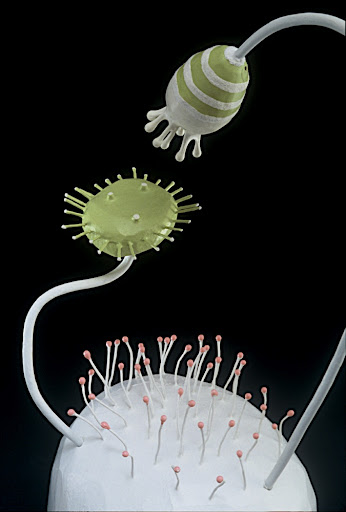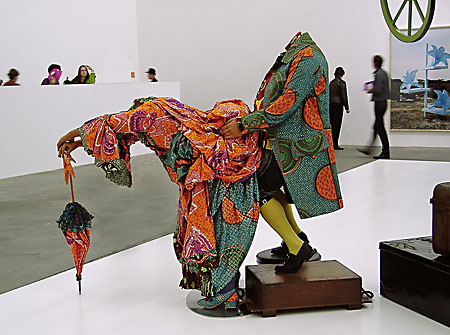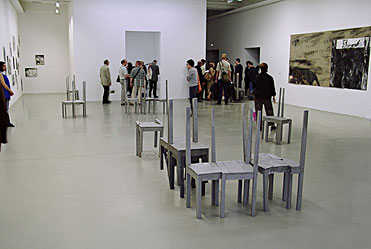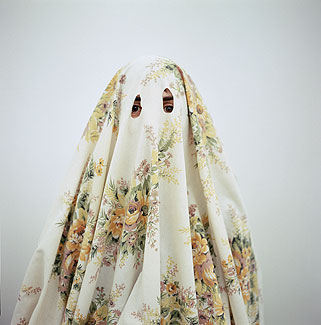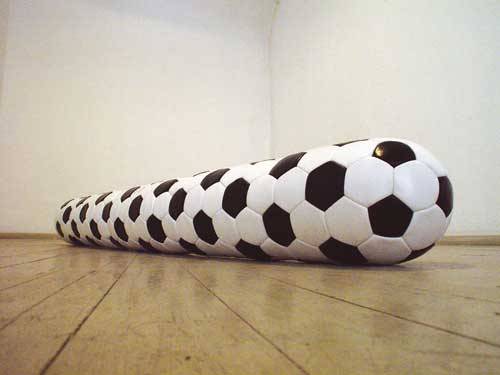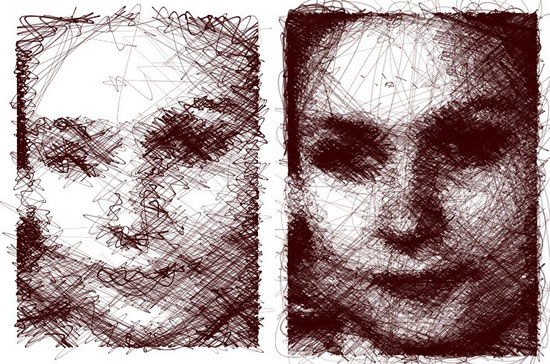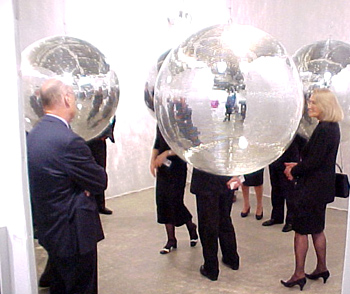Monday, May 17, 2010
Sunday, May 2, 2010
Monday, April 26, 2010
art and the body/identity
Saturday, April 24, 2010
Review Criteria
Monday, April 19, 2010
nature&technology/Deformation
is "nature art" a way to promote human interaction with nature or is it just the artist imposing their will on an already established system?
Monday, April 12, 2010
Art and Representation/Narrative
Is representation in art a better way to engage the audience or is it just an easier way to garner attention?
Is it possible to create narrative without representation?
Can a strong narrative function the same way as a strong formalist work?
Monday, April 5, 2010
Armory Show Review
Impressions from the Armory Show March 4-7 are nothing if not overwhelming, with both pier 92 and 94 jam packed with 117 contemporary dealers and 67 modern dealers and their most “important” works. Promising in a way that will attract buyers and allow the gallery to return next year. The show was divided into two sections; one for more contemporary works and the other was a modern section.
The general aesthetics of the contemporary area comprised a large number of galleries, which included photography of everyday life, or candid scenes. These are categorized by photographs in which no apparent alteration of the image has been made, the photos appear to be representations of the human condition in its most mundane form. The number of galleries with such work ranges in the twenties, and this is on the lower end of what could be considered the same type of work, as photos which deal with the same ideas or are slightly altered where not included in the tally.
Another common thread among the galleries was art that was made up of garbage, or had the aesthetics of garbage. The artist gathered presumably random objects and arranges them in a pile or glues them together or hangs them together. These works were also much more prevalent than the thirty or so galleries that were included, but those works were not entirely comprised of “garbage”. While this was the aesthetic that prevailed at the show, there were many outliers outlined subsequently.
One of the first things available coming down the stairs at the Armory show is the Reed Seifer “Spray to Forget” display. The exhibit has all the makings of fairground snakeoil salesman with the clean simple aesthetics of the times. The spray is supposed to allow a person to let go of a bad memory and replace it with a good memory, and includes a mixture of natural oils championed by aromatherapy. Not only is the display reminiscent of a con game, the research in memory is completely non-existent. While there are substances capable of altering the strength of memory it is impossible for and oily spray to do so. The human memory is one of the most unique and complex systems on the planet and to propagate the notion that a perfume can in any way alter it is grossly irresponsible.
The Rachel Uffner Gallery featuring works by Australian artist Hillary Harnischfeger. These wall sculptures range from 10in to 36in across and are made of mixed materials including paper, plaster and ink. The surface resembles that of a cliff face but of a different palette, this one being of a pastel wet-envelope variety rather than that of a craggy desert. The materials are layered and stacked to form larger flat shapes and then cut and turned upward to reveal the striations of the layers. The work is incredibly engaging due to the complexity of the imagery and the levels in which one may investigate, the depth of the work physically is matched its psychological depth.
Sachiko Kodama had a display near the stairs of the contemporary exhibit, the sculpture “Fountain ?” was a tiny cone sitting in a pool of oily liquid under a glass vitrine. The liquid is magnetic and goes through a cycle in which it winds up the cone and then becomes spikes that grow to a point and then recede or cascade up and down the cone. There is a projection on the wall of the sculpture going through its cycle as well. While it is and interesting phenomenon and is a beautiful chocolaty color and movement, there is hardly more to the sculpture than the display of this new stuff. This particular piece is one of the more mundane in the series usually the liquid reacts to sound and some are more of a still pool in a bowl rather than a cone that becomes spiky, the mystery in these other works is absent in “Fountain ?” and one wonders if the fact that it needed to be displayed covered in any way informed the choice to show this piece in particular.
Overall the work at the show was disappointing, with a small percentage of galleries which included things other than those state previously and in that small percentage and even smaller number of interesting, unique, and well-crafted works. The real disenchantment is that the armory show claims it is including the most important art of the 20th and 21st century, the fact that so much of it is the same and so much of it is strategically chosen to be attractive to collectors really negates the idea of it being important.
Thursday, April 1, 2010
Monday, March 8, 2010
Treatise of Navigation
Sunday, March 7, 2010
Monday, March 1, 2010
Sunday, February 28, 2010
Radicant Aesthetics
I think the aesthetics of a Radicant artist is the same as a post-modern artist in that it is obviously not driven by any sort of underlying narrative or movement. The only difference is that altermodernism isn’t fueled by anger or reaction against art history. This precariousness is something that began with post-modernism and what Bourriaud is bringing forth is a new way of talking about it.
Bourriaud is also proposing that “The distance between things and living things is diminishing”(p94) Is this a reference to the ever narrowing gap between computer technology and the human brain?
He also talks about the Semiounaut, as a “creator of paths in a landscape of signs.”(p100) Who are these pathways for? If they are for us the purveyors of the art world these paths are unnecessary as we are already aware of the pathways by being members of the cognoscenti and creating our own paths within our own work. And if the paths are for the public then they are invisible, as the greater population does not poses the knowledge necessary in order to suss them out.
Another point Bourriaud makes is that “the artwork is no longer a terminal object but merely one moment in a chain.” (p106) This is also something seen since the early days of art history; When we talk about John Armleder deconstructing and re-constructing his work we see it as new because a new language has been built around it. But since the beginning of art history we have looked at works within the context of its relationship to other works by the same artist, and though at the time it was probably thought of as “terminal” it really isn’t if there is more than one work of art to measure it against. It is a different way of thinking about contemporary art but any work from any time can be deconstructed.
Monday, February 22, 2010
postproduction
altermodernity
Bourriaud comments that when faced with art made by someone different from us, or of a minority we do not have the right to critique it because we cannot understand it, therefore we will become unable to attribute a value to the work. But isn’t it possible to acertaine intent, materials, and composition purely upon the formal aspects of a work? If we preoccupy ourselves with the content of work whose origins we cannot understand then perhaps that is why the modernists dismissed all other aesthetics and ideas in opposition with purity and utopia.
Post modernism is supposedly based in “respect for the other” in which we pretend to assign worth to the arts of other cultures, without challenge, because it is of something we cannot understand and instead of attempting to find a place among our own ideas of art it is labeled first by its country of origin in order to frame the critique through the lens of that specific culture.
Modernism, says Bourriaud, is based in the “root”, this is something I have difficult time believing as I was under the impression that modernism was about Utopia and Purity, and what about those concepts is concerned with origin? Utopia will not rise up in the minds of people who appreciate their current status and society, it is only when we through away what has been done before that Utopia can be achieved. Kazimir Malevich claimed that modernism there is a “passion for the beginning” and because of this it sews the seeds of the future, thus establishing the root. If we imagine modernism as being “rooted” in its own ideas then the metaphor holds water, then the disregard of other cultures and ideas that don’t stem from “the root” will not be allowed.
How is the work of Duchamp and Kazimir Malevich and anomaly within modernism? Bourriaud says that this work was produced outside the natural progression of art history and thus was able to “produce history”. Is this purely based on the ideas that these two had and how they were in opposition to the consensus at the time? Aesthetically the work seems very much in keeping with the “natural Progression” so perhaps it was the language they used to describe there art that made it different? If a readymade informs the future, and it is an object taken from everyday life, how is this not an extension of modernism and “the root”?
I don't really understand what altermodern work looks like.
Monday, February 15, 2010
postproduction
The definition of original is: not derived or copied or translated from something else. With this in mind one can presume that the idea of originality is only an idea, because when you disallow derivation or influence there is nothing that can be made with the label of original. Everything comes from something; this is true for all existence and especially for art. What is art if not a culmination of experience expressed tangibly, and that experience did not accrue in a vacuum, nor did it stem exclusively from the internal monologue of the mind. We are products of our environment and history, and therefore so is the art that we make.
Copyright of intellectual property assumes that an individual is capable of creating without the direct influence of their environment, relationships, or experience. This is a false assumption as there needs to be an impetus for any creation, and motivation comes from influence and ideas we encounter throughout our lives and is impossible to divorce our desire to think and create from the reality we experience.
The film industry is in financial trouble, because of bootleg copies of films being made and distributed on the Internet. Arguments have been made that this must be stopped if we want quality films to be made, If the film industry is loosing money then they will only make films they assume will be blockbusters and won’t take chances on more independent, fringe type ideas. If this is indeed the case, and interesting, thought-provoking movies are not cost effective, then perhaps the public will abandon the film industry for the Internet entirely. If the machine is no longer able to function then it must be upgraded or deserted.
http://www.pbs.org/nbr/site/onair/transcripts/051109/
http://www.pbs.org/newshour/bb/entertainment/jan-june04/black_04-12.html
Process is the way to actually own any work. If one is absorbed in the process of creating something then the value is attributed to the individual. It won’t be possible for the act of making to be co-opted by the masses, they can copy the process but what is gained is different for every individual based on their previous experiences.
Monday, February 8, 2010
Benjamin Assignment
A) The aura of a work of art is perception of distance from a work, its inherent uniqueness.
B) Mechanical reproduction according to Benjamin was something that brought art to the viewer; it met the audience halfway in that it was possible to make works in massive quantities so that they could be brought into the home. This in turn was a process that extracted the aura of a work because it was stripped of its uniqueness.
C) Mechanical reproduction emancipated works of art by the negation of labor intensive, time consuming process. There is no longer a ritual to follow when all the work is done by a machine, the technical skill that was once primary, became secondary and the reverence of an artist’s position was diminished. Conceptualizing ones design was a way to adapt to this new direction. The ideas an artist starts with became paramount and the works became more and more abstract.
D) Some processes changing art are: rapid prototyping; 3D printers, Laser printing on canvas, digital photography, computer generated graphics, web sites, assembly lines, factories.
Monday, February 1, 2010
modernism/post
1.The Modern art movement began around the turn of the century when the imagery of painting became less photographic and more optical, its when art became more about what could be seen in the light and shadow than any actual objects. The height of modern art was when Clement Greenberg introduced Formalism and nurtured and promoted artists who became source material to support his argument of the evolution towards “purity”
2.Modern art ended with the destruction of Pruitt-Igoe, a modernist housing project that failed after a mere 20 years. This was one of the first demolitions of modernist architecture and has been called the “end of modernism”
3.Modern art movements, after Clement Greenberg “established a theory of artistic progress” became the expression of pure opticality. There was only the object flat on the wall or a mass of space in a room. No narrative or referential imagery were allowed, that was not an evolution towards purity. Artists like Mark Rothko and Jackson Pollok are examples of pure painting, only paint and canvas, it is not a window into another space or symbolic of anything it is only itself.
4. The Post-Modern art movement was a reaction against modernisms purity, but more than that it was a reaction against art history, the rules of the past were no longer acknowledged by Post-Modernists. Anything and everything was allowed in Post-Modernism if only to throw off the chains of formalism and “purity”. Minimalists made huge objects; which forced the audience to engage the work. Pop Art allowed references to popular culture, perhaps even including popular culture within the realm of “art”.
5. niche egotism, I call the current movement this because there are an infinite number of pockets of artist communities, all of which feel they are making the real art. This probably started around the late nineties when the internet took off because it made possible about a billion more kinds of art and aesthetics and fragmented the population to fit into all these new little mini-movements.
